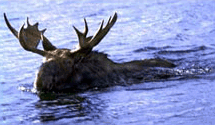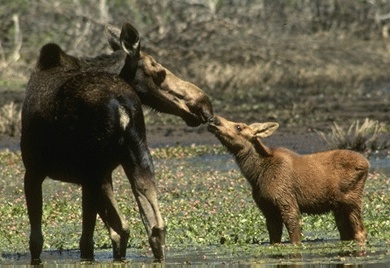

Their eyesight is poor but their hearing and sense of smell are excellent and so compensate. Due to a shortage of cones, which provide colour sensitivity, moose are colour-blind. Their retina is composed mainly of rod cells so would see the world as a spectrum of varying grey. Rods also provide excellent low-light and motion capability, but don't give moose the acuity or sharpness of detail that humans enjoy.
Moose are not normally aggressive, however, they can be very aggressive when hungry, tired or harassed by people, dogs, and traffic (sounds familiar!). During the mating season bull moose are often more aggressive toward people. Mothers with young calves are very protective and will attack humans who come too close.
You can identify when a moose might attack if the long hairs on its hump are raised and it's ears laid back. A moose may also lick its lips.
Charges may only be "bluffs", warning you to get back, however take this seriously, even a young calf could cause significant injuries from it's size alone. When a moose does charge, it often kicks forward with its front hooves. Unlike other animals, such as dogs and bears, it's usually a good idea to run from a moose because they won't chase you very far.
Cows commonly give birth to twins and occasionally triplets. After the young are born, they drink the mother's milk, which is very high in fat and other nutrients. Because of the milk, the calf grows very fast and so offspring can browse and follow their mother at 3 weeks of age and are completely weaned at five months. They stay with their mother for at least a year after birth, until the next young are born.

The two photos show a male moose(top) and a female with it's young(left). The correct name for female moose is a COW, the male is called a BULL and the young moose is called a CALF.
Mothers are extremely aggressive and very protective of their calves, most probably due to the scarcity of food in the Winter, their greatest threat to survival.
Moose tend to be solitary animals but gathering in higher densities, up to a dozen or more, for the breeding season. Only 25% of groups have more than two adults. Each group, were possible, would occupy an area of 300-600 hectares.
An interesting talking points exists over the plural of the word moose but my feelings are that the correct form, MOOSE, is inadequate. Imagine the greater pleasure of encountering a group of MEESE roaming the countryside.
Moose, like other deer, are ruminants ("chew their cud"). They have a four-chambered stomach and their digestive systems contain micro-organisms that break down vegetation.
It is illegal, and very dangerous, to feed a moose. This is because moose that are fed by humans often become aggressive when they are not fed as expected, for example, they may attack the next person they see if that person has no food to offer.
Moose can be identified from other deer by their unique foot prints mainly due to the sheer size of the hooves (see below). Cows and young bulls leave pointier tracks and like other deer, the sharper end of the heart points in the direction of travel. Moose strides are usually around 30" to 40" long.
It is quite clear from the prints that each of its feet has two large hoofed toes and two smaller toes.

(Please note these details are simply for information and under no circumstance do I condone moose hunting.)
Another threat to moose is the winter tick. Tick infestations irritate the moose's skin, causing the moose to rub off portions of the hair they depend on for protection from the extreme winter cold, which typifies much of their habitat. Severe winters combined with heavy tick infestations can reduce moose populations as much as 50 percent.
Other causes of death include hunting, collisions with cars, parasites, and malnutrition due to gum disease.
... or return home.